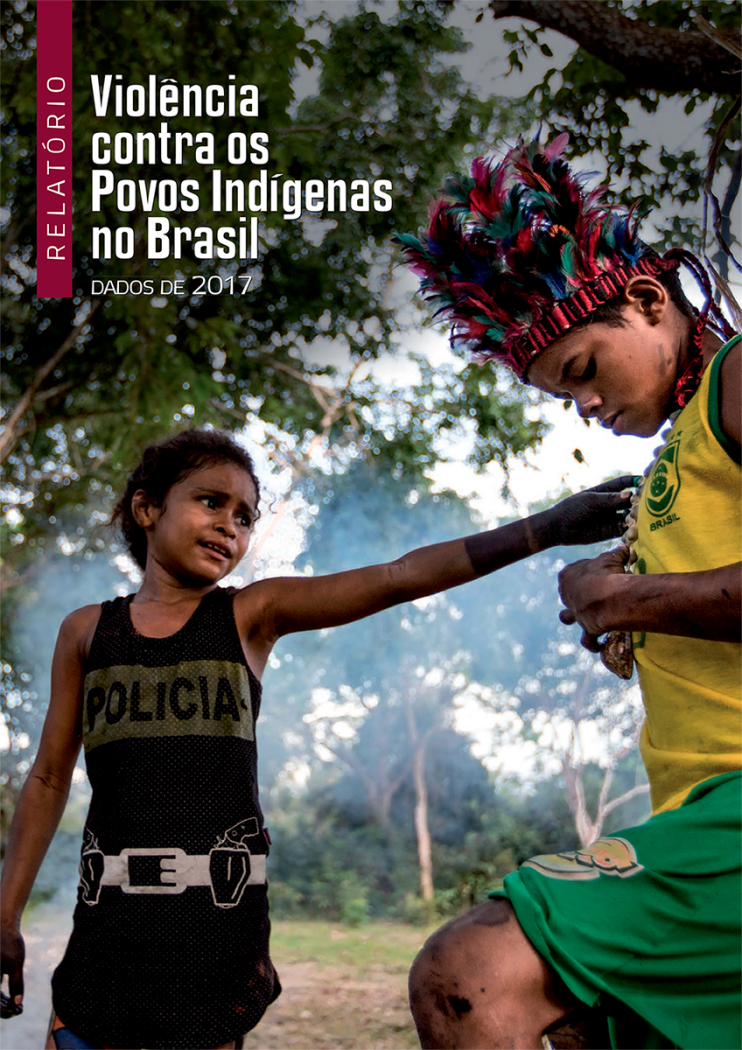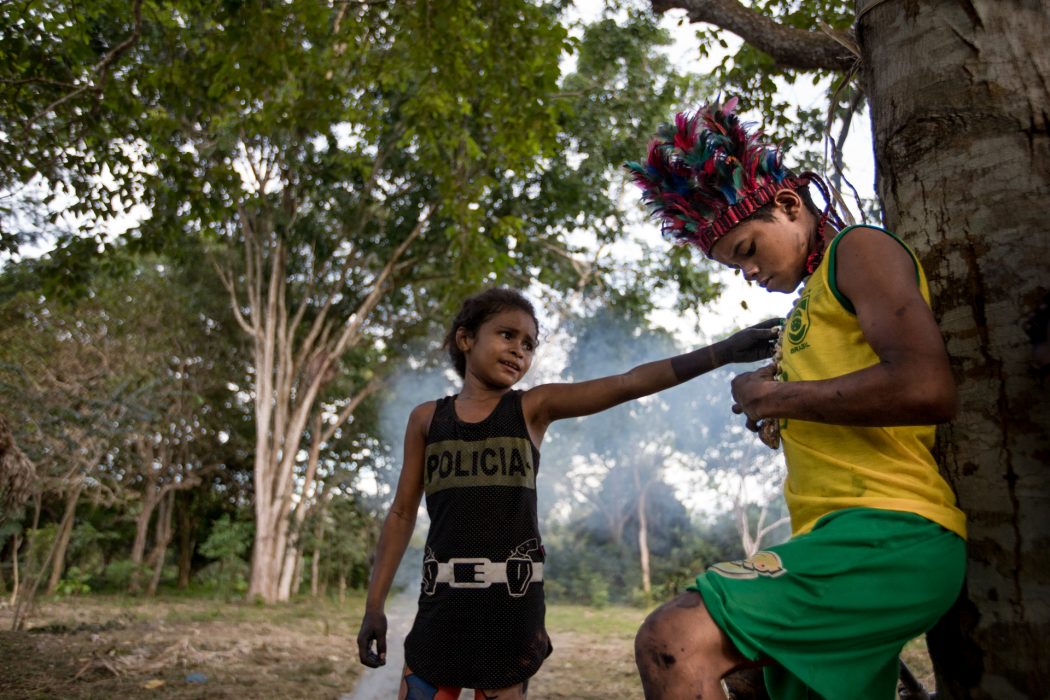Cimi’s Report: Brazil sees a systematic and continuous increase in violence against indigenous peoples
The Report Violence against Indigenous Peoples in Brazil, published annually by the Indigenist Missionary Council (CIMI), shows in 2017 an increase in 14 of the 19 types of violence documented; indigenous lands are one of the main vectors of violence
 Brasília (DF) – There has been an increase in cases of 14 of the 19 types of violence documented in the Report Violence against Indigenous Peoples in Brazil – Data for 2017, published annually by the Indigenist Missionary Council (CIMI). In three types of violence, the number of cases reported equaled that of the previous year; and only two types of violence showed a decline as compared to 2016. However, these two pieces of data are partial and so the number of cases may be higher, according to the Special Indigenous Health Secretariat (SESAI).
Brasília (DF) – There has been an increase in cases of 14 of the 19 types of violence documented in the Report Violence against Indigenous Peoples in Brazil – Data for 2017, published annually by the Indigenist Missionary Council (CIMI). In three types of violence, the number of cases reported equaled that of the previous year; and only two types of violence showed a decline as compared to 2016. However, these two pieces of data are partial and so the number of cases may be higher, according to the Special Indigenous Health Secretariat (SESAI).
The information collected shows that the number of suicides (128 cases), murders (110 cases), child mortality (702 cases), and violations associated with traditional land rights and their protection is still astonishing.
“This edition of the Report makes explicit a reality of absolute legal uncertainty regarding the individual and collective rights of indigenous peoples in Brazil. To make matters worse, the three branches of the Brazilian government have been complicit in the pressure on indigenous territories, which allows their natural resources to be exploited and leads to violence in the villages,” explains Roberto Liebgott, coordinator of CIMI’s South Regional Office and one of the organizers of the report.
He adds, “In addition, the ruralists have been playing a particularly active role in ensuring the necessary conditions to establish a new process of dispossession of traditional lands in the country. In other words, the strangulation of indigenous lands by various vectors is actually intended to usurp the lands of Brazilian indigenous peoples.”
Against the heritage
In this regard, special mention should be made of the increase in the three types of ‘violence against heritage,’ which form the first chapter of the Report: omission and delays in land regularizations (847 cases); conflicts over territorial rights (20 cases); and possessory invasion, illegal exploitation of natural resources and other forms damage to heritage (96 cases reported).
One can see a significant increase in invasions; theft of natural resources such as timber and minerals; illegal hunting and fishing; soil and water contamination by pesticides; and fires, among other criminal actions. In the previous year, 2016, 59 cases had been registered – thus representing a 62% increase in 2017.
In addition to violations of indigenous peoples’ rights to the exclusive usufruct of their lands and the resources contained therein, these crimes are aggravated by the fact that they are accompanied by intimidation, threats and often physical acts of violence against indigenous people, including attacks on communities.
This is the case with the Karipuna people in Rondônia. Almost extinct at the time of the first contacts with the non-indigenous society in the 1970s, the Karipuna people cannot walk freely through their territory, which was ratified in 1998. In addition to a significant increase in cases of invasions in the Karipuna indigenous land since 2015 for timber theft, land grabbing and land subdivision are other crimes that the indigenous people have been repeatedly reporting to Brazilian agencies and even to the United Nations.
CIMI found that the government of President Michel Temer did not ratify any indigenous land in 2017. This fact places him as the worst performing president in this area – much worse than Dilma Rousseff, who left the government with the lowest annual average (5.25) of indigenous land ratification by a Brazilian president since the reintroduction of democracy in 1985. Last year, the Ministry of Justice signed only two Declaratory Ordinances and the National Foundation for Indigenous People (FUNAI) recognized six lands as traditionally occupied by indigenous peoples.
Of the 1,306 lands claimed by indigenous peoples in Brazil, 847 (accounting for 64%) are still waiting for the State to finalize the demarcation process and register them as traditional indigenous lands with the Federal Heritage Department (SPU). Of these 847 lands, 537 (63%) have not yet been subject to any measures by the State. Considering that the Federal Constitution of 1988 required the demarcation of all indigenous lands in Brazil by 1993, it can be clearly seen that the executive branch has been completely negligent in fulfilling this constitutional obligation.

In April 2017, the Akroá-Gamella people were severely attacked in Maranhão. Photo: Ana Mendes
Against the person
With respect to ‘violence against the person,’ one can see a further deterioration in seven of the nine types of violence under analysis: attempted murders (27 cases), involuntary manslaughter (19), death threats (14), various threats (18), aggravated battery (12), racism and ethnic-cultural discrimination (18), and sexual violence (16). As regards abuse of power, the number of cases equaled that registered in 2016: 8 cases.
In 2017, 110 indigenous peoples were murdered, eight fewer than in 2016. It is worth mentioning that SESAI itself acknowledges that this is a partial data, as the institution may be notified of new murders. It thus becomes evident that the real situation of indigenous murders can be even more serious.
The three states that reported the highest number of murders were Roraima (33), Amazonas (28), and Mato Grosso do Sul (17). These data provided by SESAI on “deaths by assault” do not allow in-depth analysis, as there is no information on the age group and the indigenous people to which the victims belong nor on the circumstances of these murders.
Worthy of note among the cases of violence against the person is the massacre perpetrated against the Akroá Gamella people in Maranhão on April 30, 2017, when a group of approximately 200 people severely attacked the indigenous community, which has been retaking possession of its traditional territory since 2015. In the attack, 22 indigenous individuals from the Gamella people were injured, two of whom were shot and two others had their hands cut off. The other Gamella individuals were severely wounded by machete blows and attacked with stones and sticks.
Although the call for the attack was announced through a local radio program and sound cars driving through the streets of municipalities around the area occupied by the Gamella people, government agencies took no action to stop this act of violence. Indigenous people say that police officers would have even witnessed the violence and blamed the Gamella people for the situation.
With the intensification of the struggle for their ancestral lands, leaders of the Gamella people have been threatened and criminalized and the community as a whole has been harassed and suffered physical and symbolic violence in several places, including hospitals, where they do not receive health care, and schools – in addition to having their crops burned, among other biased actions.
Government omission
Based on the Law on Access to Information, CIMI also obtained from SESAI partial data on suicide and child mortality rates among indigenous peoples. Of the 128 suicide cases registered by SESAI in 2017 throughout the country (22 more than in 2016), the states with the highest number of cases were Amazonas (54 cases) and Mato Grosso do Sul (31 cases).
Regarding the under-five child mortality rate, of the 702 cases recorded, 236 occurred in Amazonas, 107 in Mato Grosso and 103 in Roraima. It should be noted that, as with data on murders, SESAI’s information on suicide and child mortality rates is partial and subject to updates. This is to say that these data can be even more serious.
CIMI’s records show that the number of cases of lack of health care (42) and general lack of health care (42) in 2017 equaled that of the previous year. On the other hand, there was an increase in the number of cases of death from lack of health care (8 cases), spread of alcohol and other drugs (10 cases) and lack of support for indigenous school education (41 cases).
CIMI’s Report also analyzes the current political situation and some specific issues, such as the threat to the future of isolated peoples (who avoid contact with non-indigenous society); the unconstitutionality of Opinion 001 issued by the Federal Attorney General’s Office – which, like the Time Frame, underlies the new forms of disseisin; the budget for indigenous policies; and the need for the Brazilian State to provide redress to indigenous peoples who have been and continue to be victims of violence and rights violations, as is the case with the Karipuna people.
In his article presenting the Report, CIMI’s executive secretary, Cleber Buzatto, remarks: “Under the Temer administration, perpetrators are feeling safer to commit their crimes. Invasion and disseisin have spread like wildfire across indigenous territories and threatened the survival of many peoples, including isolated ones. It is clear that Brazil has been taken by storm and is being held hostage by private interests of the agrarian elite, ‘graced’ with new ‘hereditary captaincies’ that are distributed in exchange for the death of the peoples inhabiting the territories.”

